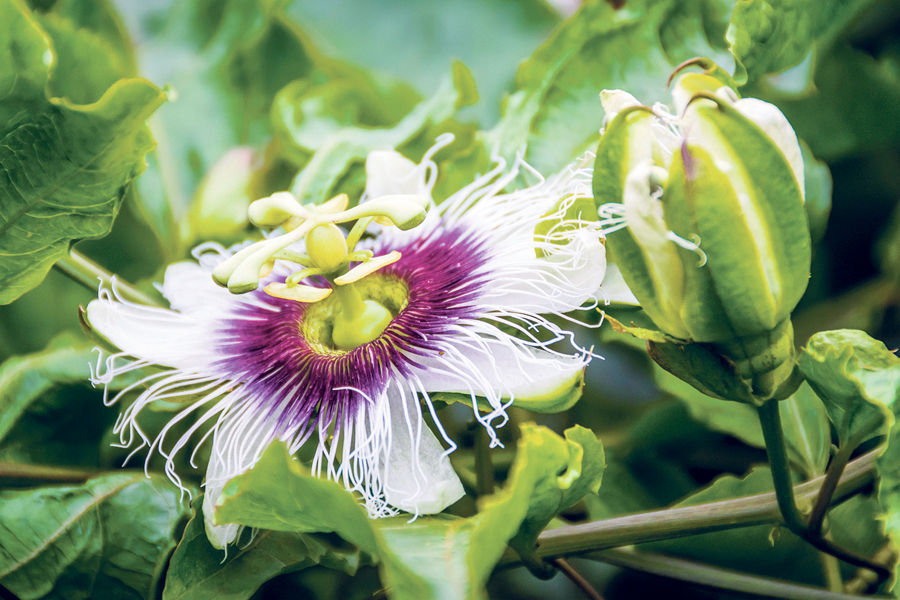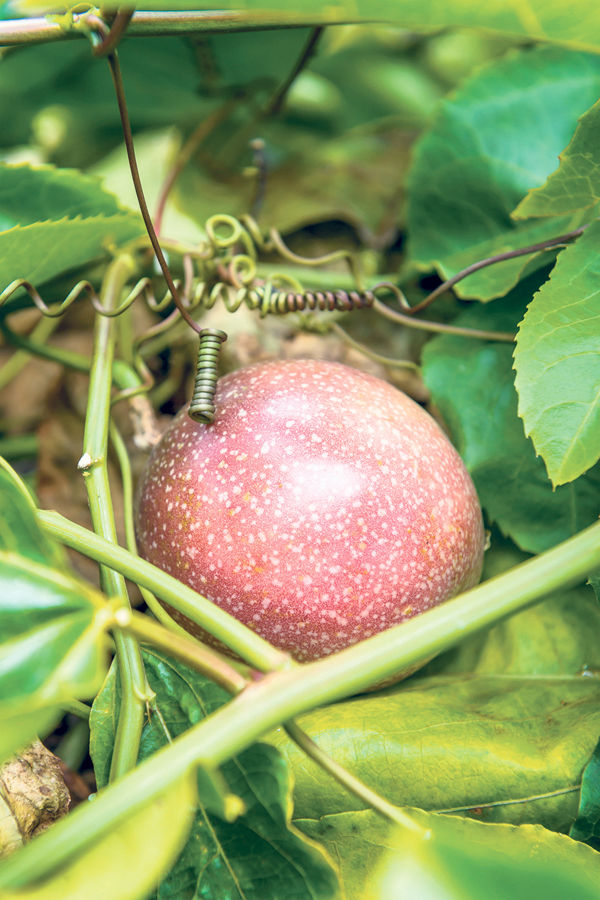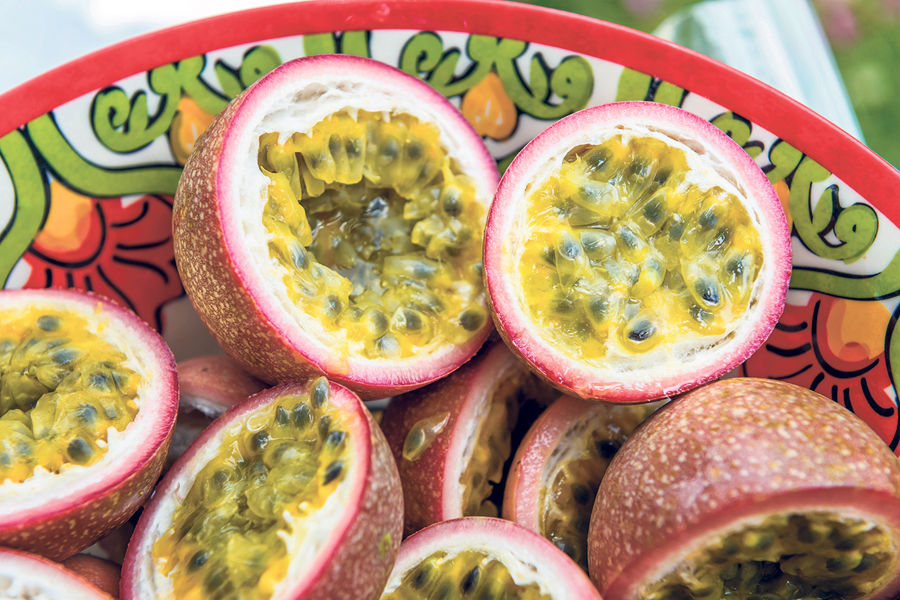Praise for passion fruit
Yoshii Farm grows tropical fruit on more than 30 acres. Dickie and Linda Yoshii started farming in Kauai in 1975. Their son Richard is taking over the farm and preserving it for his 2-year-old son, Leighton.
What’s growing now
Apple banana, avocado, bonsai (juniper, jade, desert rose), breadfruit, calamansi, caimito (cream apple), chico, chili peppers, culinary herbs, dragon fruit, flowers, ginger, grapefruit, guava, jackfruit, limes (Tahitian), longan, passion fruit (purple), lychee, macadamia nuts, mango, mamey sapote, mountain apple, oranges, papaya, pomelo, rambutan, soursop, star fruit, Surinam cherry, tamarind, tangelo, tangerines, taro (dry-land)
Purple passion fruit
Passion fruit is a high acid food that contains about 14.45 grams of sugar per 100 grams of edible portion. The acids and sugar help to create a unique taste and serve as a preservative nature for the tropical fruit. The skin is purple, juice is light yellow and the flavor is sweet, somewhat floral and lightly tart.
Of the estimated 500 species of Passiflora, in the family Passifloraceae, only one, “P. edulis Sims,” has the exclusive designation of passion fruit. Within this species, there are two distinct forms, the standard purple, and yellow. Purple passion fruit may be called purple, red, or black granadilla, or, in Hawaii, lilikoi; in Jamaica, mountain sweet cup; in Thailand, linmangkon.
Purple passion fruit is native to southern Brazil, Paraguay and northern Argentina. In Brazil, purple passion fruit is eaten fresh and yellow passion fruit, which is stronger in flavor and color, is used for juice processing and preserves.
In Hawaii, seeds of purple passion fruit were brought from Australia and first planted in 1880. The vine came to be popular in home gardens and quickly became naturalized in the lower forests. By 1930, purple passion fruit could be found growing wild on all of the islands in the Hawaiian chain.
On Kauai in the 1940s, a Mr. Haley attempted to market canned passion fruit juice in a small way but the product was unsatisfactory and World War II terminated his efforts. A Kauai processor produced a concentrate that was sold in glass jars and this project, though small, proved successful.
In 1951, when Hawaiian passion fruit plantings totaled less than five acres, the University of Hawaii chose this fruit as the most promising crop for development and created an industry based on quick-frozen passion fruit juice concentrate. From among Mr. Haley’s vines, choice strains of yellow passion fruit were selected, which gave four times the yield of the purple passion fruit and had a higher juice content. By 1958, 1,200-acres on Kauai were devoted to yellow passion fruit production.
Season
Passion fruit matures from June through January, with heaviest crops in July, August, October and November.
What to look for
Select fruit that is lemon yellow or dark lavender, with smooth, shiny skin and little to no dark spots. Some people say wrinkled fruit are sweeter, but I have not found that to be true.
Storage
Passion fruit rapidly ripens at temperatures of 86 degrees F, but will keep for a week in the refrigerator.
Preparation
Inside the fruit, juice sacs cling to small black seeds. Some people like to slice passion fruit in half and scoop the pulpy seeds directly into their mouth. Others add seeds to preparations such as cheesecake and mousse for added crunch. Seeds can also be tossed into fruit salads or combined with cream and sugar.
If you prefer pure passion fruit juice, my friend Celeste Rogers Karau has an easy suggestion. Rogers is a former writer for Cook’s Illustrated magazine and America’s Test Kitchen, a show on PBS. Today, she is the manager for the Kauai Culinary Market at the Shops at Kukuiula. She recommends using an OXO food mill to extract the juice. I tried it and it does work better than blending the seeds before straining, plus there is a lot less cleanup.
Passion fruit is my favorite fruit and the bright flavor is an excellent substitute for citrus. Try it in salad dressings, dairy desserts, or in oatmeal with warm spices and honey. Make a refreshing beverage by combining juice with honey and water, or use in cocktails with Koloa Coconut Rum.
Passion fruit juice can be boiled down to make a syrup, which is used in making sauce, gelatin desserts, candy, ice cream, sherbet, cake icing, cake filling, meringue or chiffon pie. The seeded pulp can be made into jelly or combined with pineapple or tomato in making jam. Passion fruit pairs well with dark chocolate, citrus, coconut, cream, pineapple, mangos, and papayas.
Tip
Passion fruit juice can be frozen in ice cube trays for later use.
Health benefits
Passion fruit is a good source of vitamin C and vitamin A. Vitamin C functions as an antioxidant that reduces free radical damage. Vitamin A plays important roles in the maintenance of vision and skin care as well as cell growth, and reproduction. Thirteen different carotenoids have been identified in passion fruit, some of which have been found to have anticancer properties.
Yoshii Farm produce can be found at
Farmers Markets: Kukui Grove, (Mondays at 3 p.m.), Waipa (Tuesdays, 2 p.m.), Kapaa (Wednesdays 3 p.m.), Kilauea (Thursdays, 4:30 p.m. and Saturdays, 9 a.m.), Hanalei (Saturdays, 9:30 a.m.) Restaurants: Lappert’s Hawaii. Grocery: Times Lihue, Papayas Natural Foods and Cafe, Harvest Market.
Lilikoi mint chiffon pie
This recipe is adapted from A Taste of Hawaii: New Cooking from the Crossroads of the Pacific written by Jean-Marie Josselin, owner of Josselin’s Tapas Bar & Grill and the soon-to-open Jo2. Even though Lilikoi Chiffon Pie is ubiquitous in Hawaii, I wanted to share this recipe because of the strong passion fruit flavor, and use of all natural ingredients.
5 eggs, separated
3/4 cup superfine sugar
2/3 cup passion fruit juice
6 mint leaves, sliced
2 1/2 cups all-purpose flour
1/2 cup sugar
1 cup (2 sticks) unsalted butter
1/4 cup ice water
salt
Combine flour, a pinch of salt and sugar in a mixing bowl. Cut butter into small pieces and add to flour mixture, working it in by hand until well blended.
Add water little by little, working dough by hand for 1 minute until it holds together. It should not be wet or sticky. Place in a plastic bag and refrigerate for about 1 hour. Preheat oven to 375-degrees.
On a lightly floured table roll the dough to about a 1/8-inch thickness. Place in a 9-inch pie mold, pinching it along the sides of the mold. Cover pastry with aluminum foil and weight it down with dry beans or rice so that it will not bubble. Bake for 20-minutes or until the middle is slightly golden. Set aside to cool.
Reduce oven temperature to 325 degrees. Beat egg yokes in the top of a double boiler over hot water until very thick. Gradually beat in 1/2 cup of sugar. Stir in passion fruit juice and mint leaves and keep cooking until mixture coats the back of a spoon. Strain and allow to cool.
With a mixer, blend the egg whites with a pinch of salt until soft peaks form. Gradually add the rest of the sugar and whip until stiff. Fold one third of the egg white mixture into the passion fruit mixture. Mix thoroughly, then add the rest of the whites by folding in gently. Pour mixture into pie shell and bake for 15 minutes. Cool before serving.
• Marta Lane, a food writer on Kauai since 2010, offers farm to fork food tours and is the author of Tasting Kauai: Restaurants – From Food Trucks to Fine Dining, A Guide to Eating Well on the Garden Island. For more information, visit TastingKauai.com.




